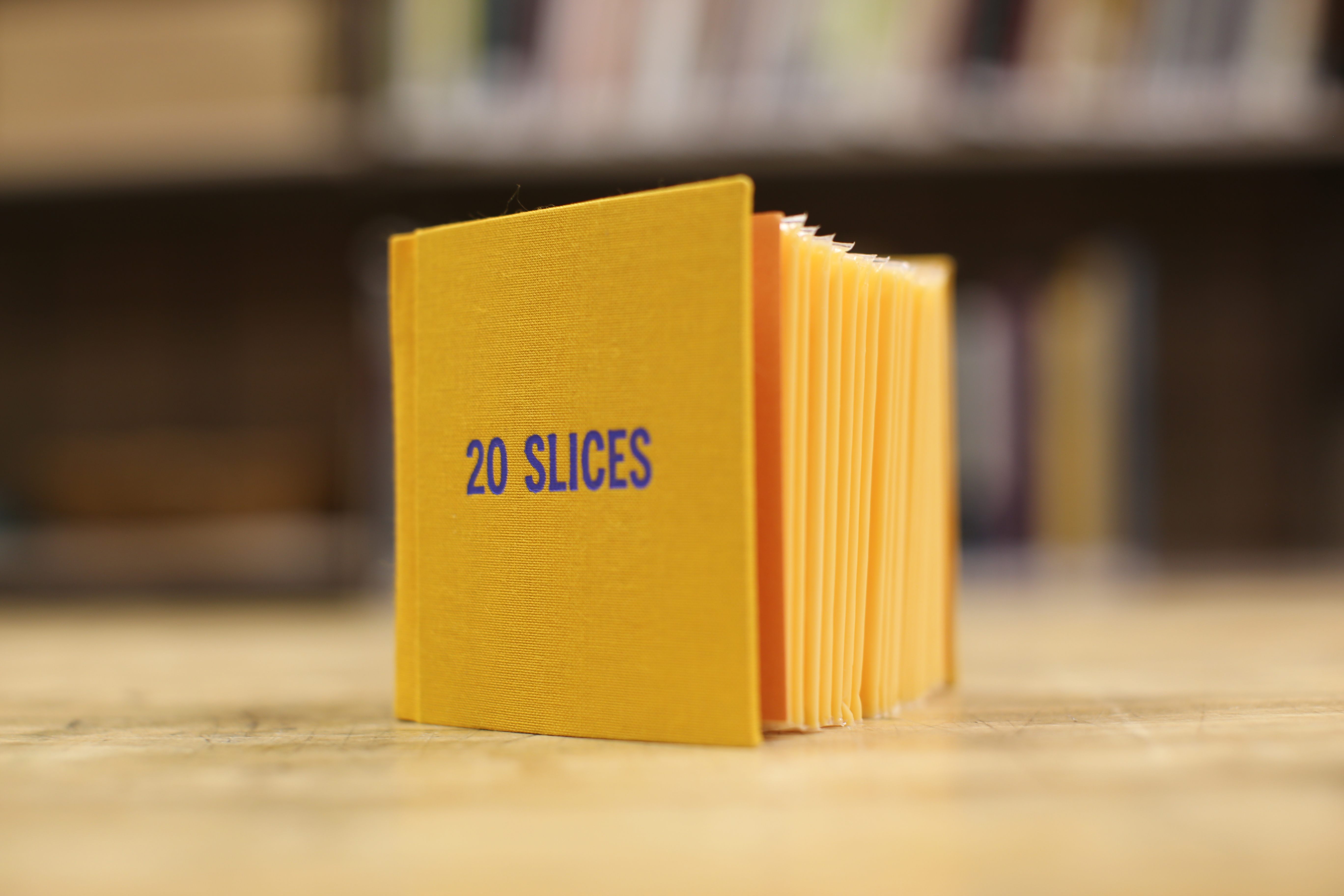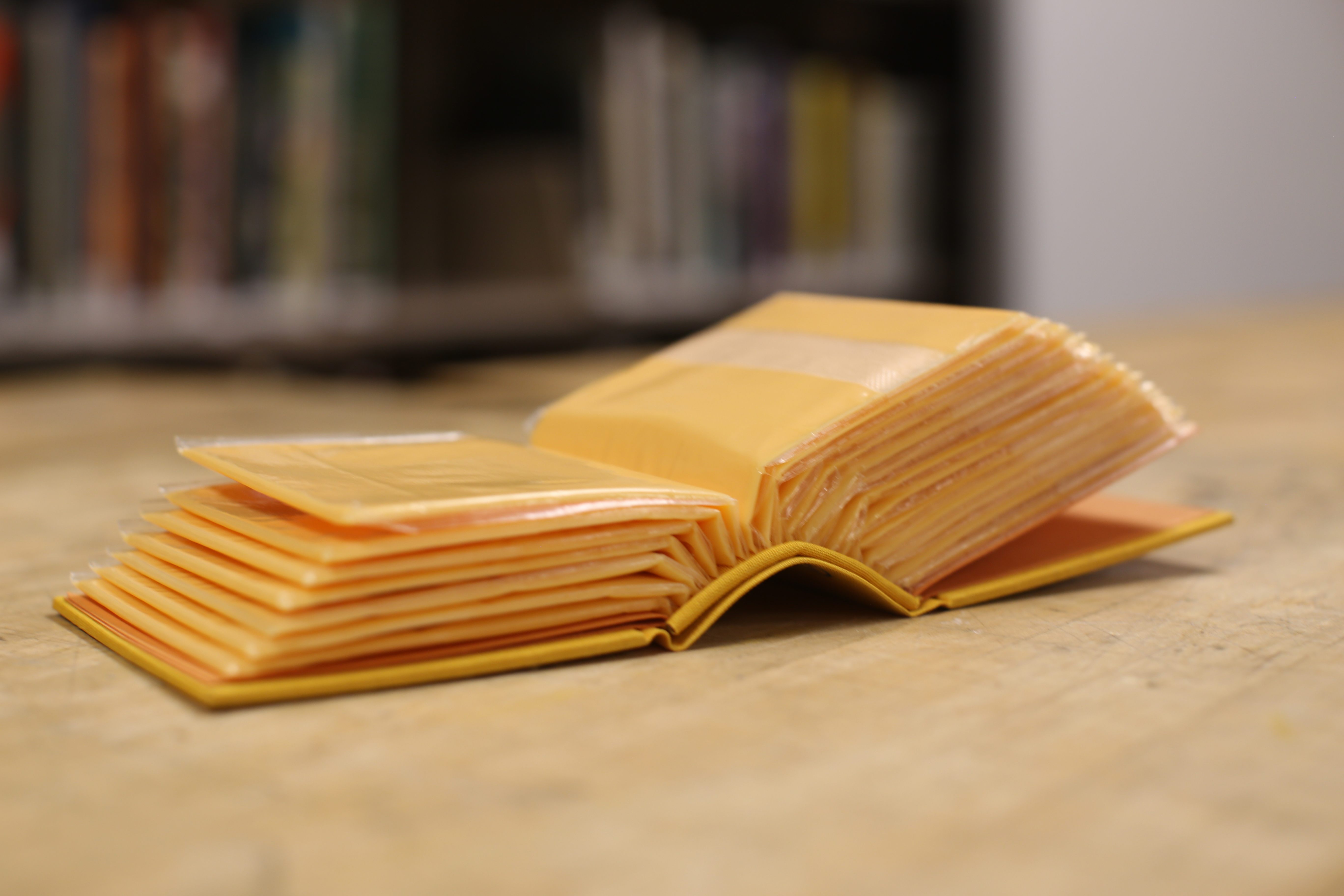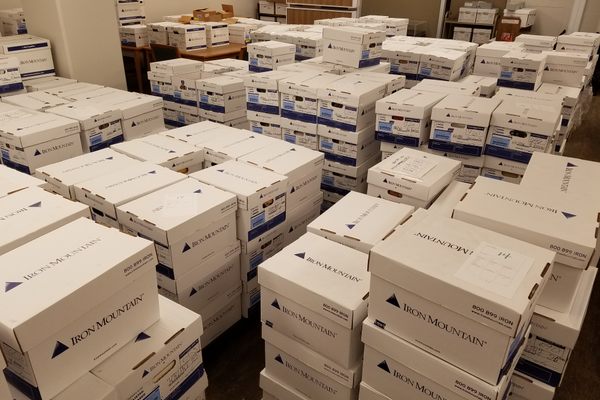Every Page of This Book Is a Slice of Cheese
And it’s sitting on the shelves at several university libraries.

What would a book look like if it were a work of art? The artists’ books collection at the University of Michigan offers almost a thousand answers: It could be a brown paper chrysalis than unfolds to reveal a small, circular book within, or eight wedge-shaped booklets printed to look like cherry pie and stored together in a clear plastic takeout container.
It could even be made of American cheese.
Last summer, University of Michigan art and design librarian Jamie Lausch Vander Broek acquired 20 Slices—a squat, square volume composed of 20 plastic-wrapped Kraft singles sandwiched between bright yellow covers. “For me, a lot of the purpose of the collection is engaging with people who usually have never seen an artist’s book before,” she explains. “So I have tailored my selections away from subtlety. It’s really important to me that people get excited about the work that I buy, and that it happens quickly.”
On that front, 20 Slices—the work of New York-based artist (and book cover designer) Ben Denzer—has been a home run. According to Vander Broek, it’s sparked more discussion than any other book she’s acquired. It even riled up librarians and cataloguers, she says, who reacted to the purchase on Twitter with comments ranging from “That’s an insult to books” to “I could do that!”

“It engaged this part of people that has a really developed, but probably not conscious, sense of what a book is and should be,” Vander Broek says. “There’s almost a morality associated with the physical nature of a book, and this was an aberration. And I thought, ‘Wow, if it can make people who talk about books every day feel like that, then this is perfect.’”
Some of her pupils have been more open-minded. “One student was like, ‘Well, you know, I think the cheese was already a book,’ and I thought that was a really astute observation,” Vander Broek says. “I think that what [Denzer] is doing is elevating things that already want to be books because they formally exhibit the characteristics of a book. There’s so much there to talk about that really gets at the nuance of ‘What is a book, exactly?’”
It’s a question Denzer has been considering since college. At Princeton, he became fascinated by books and the way their content tends to overshadow the fact that they are also objects. His senior art show featured books with wheels, books nailed shut, books repurposed into shelves, and other alterations that emphasized their physical properties over their meaning.
After graduation, he designed book covers at Penguin. For fun, he enrolled in a class at New York’s Center for Book Arts and toyed around with creating his own books. “Books take a long time to produce,” he says, “so one thing I started to think about was how to fill a book with content that wouldn’t take that long.” He experimented with napkins, fortunes, even one-dollar bills—items highlighting the fact that book pages are themselves objects. 20 Slices was his first edible creation. He’s gone on to make a book of Splenda packets, a copy of which is in the library of the Metropolitan Museum of Art. Earlier this month, he launched a limited edition of 50 books with pages made from ketchup packets, available at the Whitney Museum’s gift shop.
Food pairs well with books, he says, because both are familiar objects with familiar uses. “Ice cream, American cheese slices, and ketchup packets are all part of a shared culture. It’s a way to have some understanding of an audience, to play around with expectations and norms.” For instance: When Vander Broek went to pick up 20 Slices from the cataloguers’ office, she found it stored in their mini fridge alongside several sandwiches.
Her purchase created something of a ripple effect, set off by an article she published in Saveur. Baylor University librarian Sha Towers, who curates the school’s collection of artists’ books, was emailed by a half-dozen colleagues about the “cheese book,” and, to their surprise, he ordered it. A cataloguer working at Tufts University showed the article to Darin Murphy, head of the library’s fine arts branch, who ended up purchasing several of Denzer’s books.
20 Slices has been similarly effective for Towers and Murphy in inciting conversation amongst students. “They’re like ‘What? You spent my tuition money on cheese? How much did you pay for it? How much did you pay for it by slice?’” says Murphy. “It’s a great teaching tool because it is so provocative.”
(For those curious about the economics: A box of 24 slices of Kraft American cheese slices sells for about $3.50—roughly 15 cents a slice. 20 Slices sold for $200, or a whopping 6567% markup per single.)

“I am not in any way suggesting that 20 Slices is a one-liner,” Murphy continues. “But it has that initial impact. It shocks people.” For his part, Towers wonders if the library should have purchased a second copy and transformed it into a performance art piece, where students actually consumed the cheese rather than simply paging through it.
One of the biggest questions the book has raised is how to store it. Michigan’s head of conservation informed Vander Broek that Kraft singles are shelf stable, so she keeps it in a plastic container with silica gel packets that she occasionally swaps out. Until last week, Murphy was storing it on the shelf in his office to monitor its condition at room temperature. Now it’s been transferred to a gallon-size Ziploc to deter critters looking for a snack.
Despite American cheese’s durability, the book probably won’t last forever. That is an important part of the work, says Vander Broek. “You get information from feeling the squishy pages and from worrying about it decaying.” She compares it to 17th-century Dutch still lifes—exquisitely detailed paintings that often show fruit and meat in various stages of rot. “They make you think about death. How often do you worry that a book is going to die?” It seems that 20 Slices has brought the concept of “shelf life” to a different set of shelves.
Gastro Obscura covers the world’s most wondrous food and drink.
Sign up for our regular newsletter.



















































Follow us on Twitter to get the latest on the world's hidden wonders.
Like us on Facebook to get the latest on the world's hidden wonders.
Follow us on Twitter Like us on Facebook